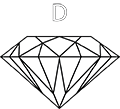
Rare, tough and the most desired gemstones in the world, It'ss no surprise it is the ultimate symbol of love. No diamonds are the same a bit like finger prints, yet they all share certain characteristics that allow us to compare and evaluate them. The way this is done is called the 4C’s: Colour, Clarity, Cut, Carat Weight and Shapes...






























